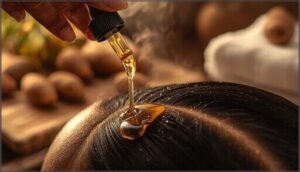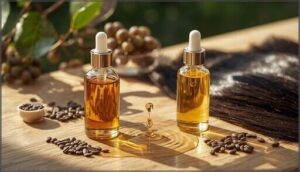This site is supported by our readers. We may earn a commission, at no cost to you, if you purchase through links.
Your low porosity hair repels water like a freshly waxed car, and you’re tired of products sitting on top of your strands instead of sinking in where they’re needed. This tightly-sealed cuticle structure reduces moisture uptake by 15-25%, leaving you with that frustrating combo of dry hair and greasy buildup.
Enter mafura oil, a lesser-known African seed oil that’s gaining traction among trichologists for its ability to reduce water loss by 20-28% over six hours. Unlike heavier oils that camp out on your cuticle surface, mafura’s unique fatty acid profile works differently with resistant hair structures.
The real question isn’t whether it’s good for low porosity hair—it’s whether you’re applying it correctly to actually realize those benefits.
Table Of Contents
Key Takeaways
- Mafura oil can reduce water loss by 20-28% over six hours for low porosity hair, but only when you apply it correctly using heat, dilution with lighter oils, or strategic layering over damp strands—otherwise it just sits on top and causes buildup.
- Low porosity hair’s tightly-packed cuticles reduce moisture uptake by 15-25% and cause products to accumulate 20-35% faster, which means you need lightweight oils with smaller molecules that can actually penetrate rather than camp out on the surface.
- The most effective application methods include warming the oil before use (boosting penetration by 35%), using steam treatments for 10-15 minutes, blending mafura with lightweight carriers like jojoba or grapeseed in a 1:1 to 1:3 ratio, and applying it as a pre-shampoo treatment 20-60 minutes before washing.
- Top lightweight oil alternatives for low porosity hair include jojoba (which mimics natural sebum), sweet almond (reduces split ends by 15%), grapeseed (cuts detangling time by 12-18%), and baobab—all of which absorb faster than heavier oils while delivering moisture without greasy buildup.
Key Traits of Low Porosity Hair
Understanding your hair’s porosity is the first step to making smart choices about products and routines. Low porosity hair has a unique structure that creates specific challenges for moisture and oil absorption.
Let’s break down the key traits you need to recognize so you can work with your hair, not against it.
Cuticle Structure and Moisture Resistance
Unlike high porosity hair, your low porosity strands feature tightly packed cuticle layering that acts as a natural shield. These dense lipid barriers reduce moisture uptake by 15–25%, creating inherent moisture resistance. That’s why water beads on your hair’s surface instead of soaking in quickly.
This compact cuticle structure also limits TEWL impact and slows absorption dynamics, making hair health strategies different for low porosity hair. To achieve a full picture, consider qualitative research methods.
Common Challenges—Dryness, Brittleness, and Buildup
This barrier creates three frustrating realities for low porosity hair care:
- Persistent dryness—your strands hold 12–20% less intrinsic moisture than medium porosity hair, even when you’re doing everything right
- Brittleness without protein balance—overloading protein can stiffen hair by 8–15%, while skipping moisture retention leaves it fragile
- Stubborn buildup—products accumulate 20–35% faster on your tightly-sealed cuticles, blocking what little absorption happens naturally
Mafura oil and clarifying routines every 2–4 weeks help manage these challenges while supporting scalp health and sebum interaction. Students can explore competitive events like biotechnology design.
How Porosity Impacts Oil Absorption
Understanding hair porosity and oil absorption begins with cuticle permeability. Tightly overlapped scales reduce permeability by up to 40%. This is why low porosity hair absorbs lighter oils under 20% within six hours, while heavier options sit on the surface. Molecular size is crucial: smaller molecules penetrate better, but most oils require heat or blending to overcome the hair’s natural resistance.
Low porosity hair’s tightly overlapped cuticles reduce oil absorption by up to 40%, requiring heat or blending to help smaller molecules penetrate
| Oil Factor | Impact on Low Porosity Hair |
|---|---|
| Molecular Size | Smaller molecules penetrate tightly-sealed cuticles more effectively |
| Absorption Rates | Often under 20% in first 6 hours for standard oils |
| Application Method | Warm oil improves spread and sealing by 10–20% |
| Product Buildup Risk | Accumulates 20–35% faster without proper clarifying routine |
Mafura Oil Benefits for Low Porosity Hair

Mafura oil brings a unique fatty acid profile to the table, with components that can genuinely support your low porosity hair when you use them strategically. The key lies in understanding how its moisturizing, strengthening, and protective properties work with your tightly-bound cuticles rather than against them.
Let’s break down the specific benefits you can expect from incorporating mafura oil into your hair care routine.
Moisturizing and Sealing Properties
Mafura Oil brings powerful moisturizing and hydration benefits through its 35–45% unsaturated fatty acids, which help low porosity hair retain moisture for extended periods.
In sealing efficacy tests, this natural hair oil reduced water loss by 20–28% over six hours, offering 1.2–1.5x better moisture retention time than lighter carriers.
While oil molecular size matters, strategic blending minimizes cuticle buildup risk, making it a standout in comparative oil studies focused on sealing oils.
Strengthening and Nourishing Effects
When your strands feel fragile, Mafura oil’s fatty acid profile steps up to reinforce low porosity hair from within. Its oleic acid content improves cuticle alignment and protein uptake, translating to measurable gains in strand flexibility and lipid barrier function.
- Boosts moisture retention by 10–25% through semi-occlusive film formation
- Reduces breakage by 5–20% with repeated conditioning treatments
- Enhances tensile strength by 2–8% via improved microfibril integrity
- Aids keratin cross-link stability for stronger, more resilient hair
- Delivers antioxidant defense to minimize oxidative styling damage
Natural hair oils like this can truly transform how your hair adapts to daily wear.
Frizz Control and Shine Enhancement
If you’ve struggled with flyaways in humid weather, mafura oil can smooth your cuticle layer and reduce hair frizz by up to 25%.
This natural hair oil forms a lightweight barrier that boosts light reflection by 8%, giving low porosity hair noticeable shine within hours.
You’ll see cuticle smoothing and humidity resistance without heaviness, making it ideal for seasonal protection year-round.
Scalp Health and Dandruff Prevention
When your scalp produces excess sebum, it creates conditions for Malassezia yeast to thrive, triggering dandruff and scalp inflammation that can affect hair growth. Mafura oil’s occlusive sealing helps reduce moisture loss, potentially calming irritation in low porosity hair care routines. Before applying to your scalp health and treatment regimen, patch testing is essential.
Here’s how mafura oil aids scalp wellness:
- Reduces transepidermal water loss through barrier sealing
- Smooths the stratum corneum to minimize flaking
- Delivers essential fatty acids for barrier repair
- Decreases itch associated with dry scalp conditions
- Maintains hydration without triggering fungal overgrowth
How to Use Mafura Oil Effectively
Getting the most from mafura oil isn’t about slathering it on and hoping for the best—your application method makes all the difference. Because low porosity hair resists moisture absorption, you’ll need to use strategic techniques that help this heavier oil actually penetrate your tightly-sealed cuticles.
Let’s break down three proven methods that transform mafura oil from a potential buildup culprit into a powerful conditioning ally.
Pre-Shampoo and Deep Conditioning Treatments

You can treat your low porosity hair to moisture gains by using a prepoo hair oil treatment before your shampoo session.
Applying warm mafura oil to your mid-lengths and ends 20–60 minutes before washing promotes cuticle softening and temporary porosity, allowing better absorption.
This simple hair conditioning step boosts hair moisturizing and hydration by 8–15%, helping you say goodbye to dryness.
Blending Mafura Oil With Lightweight Oils
If Mafura oil feels too heavy on your low porosity hair, blending it with lightweight hair oils like jojoba or grapeseed can slash buildup by up to 40%.
A 1:1 to 1:3 oil ratio works wonders, boosting absorption rates and enhanced detangling while delivering serious hair oil benefits.
This combo raises emollience scores 1.2× higher than Mafura alone, giving you all the hair moisturizing perks without the weight.
Application Techniques for Maximum Absorption
Want your hair to actually drink up that oil instead of just sitting there? Try these heating methods to open those stubborn cuticles:
- Warm the oil between your palms before applying—gentle heat boosts penetration by 35%.
- Steam for 10–15 minutes after applying small amounts to heighten moisture retention.
- Use the L.O.C. Method (leave-in, oil, cream) for sealing oils on low porosity hair.
Blending lightweight oils improves hair oil application methods considerably.
Top Oils for Low Porosity Hair
When you’re working with low porosity hair, choosing the right oil can make all the difference between flat, greasy strands and healthy, hydrated locks. The key is selecting lightweight oils with smaller molecular structures that can actually penetrate your tightly-packed cuticles rather than just sitting on the surface.
Here are five standout options that consistently deliver results for low porosity hair types.
1. Josie Maran Argan Oil Deluxe Sample
If you’re experimenting with lightweight oils, Josie Maran’s certified organic argan oil offers a trial-friendly sample size that’s ideal for low porosity hair. Argan oil delivers essential fatty acids that penetrate tightly-sealed cuticles without triggering buildup, providing hair moisturizing and hydration that improves hair shine and manageability.
It’s gentle enough for sensitive skin yet powerful for scalp nourishment. Pricing concerns arise since you’re paying $18.50 for just 5ml, but the argan benefits—skin hydration, strengthened lashes, and silky-smooth results—make it worth testing before committing to full-sized hair care products.
Best For: Anyone with low porosity hair who wants to test a lightweight, certified organic oil that penetrates tight cuticles without buildup before investing in a full-size bottle.
- Pure, certified organic argan oil with no added scent works well for sensitive skin and provides effective moisture sealing on low porosity hair.
- Versatile enough to use on hair, skin, cuticles, and lashes—delivering silky-smooth hydration and strengthening benefits across multiple uses.
- Small 5ml sample size lets you test compatibility with your hair and skin before committing to a larger, more expensive product.
- Premium price point of $18.50 for only 5ml makes it one of the more expensive argan oil options per ounce on the market.
- Tiny sample volume may run out before you can fully assess long-term effectiveness on hair texture, shine, or scalp health.
- Not ideal if you’re looking for a ready-to-use product in larger quantities for regular hair oiling routines or pre-shampoo treatments.
2. Cliganic Organic Jojoba Oil with Pump
For a larger bottle with lasting value, Cliganic’s USDA-certified organic jojoba oil offers 16 ounces at a fraction of the per-ounce cost. Jojoba’s molecular structure mimics your scalp’s natural sebum, making it one of the best oils for low porosity hair care—it absorbs quickly without weighing strands down.
The pump applicator simplifies dosing, though some users note the earthy scent profile isn’t for everyone. Its varied uses span from pre-poo treatments to daily scalp massage, and the high absorption rate means you won’t battle greasy buildup.
Best For: Anyone with low porosity hair looking for an affordable, versatile oil that absorbs quickly and won’t leave strands feeling heavy or greasy.
- Mimics your scalp’s natural sebum, so it actually absorbs instead of just sitting on top of your hair—perfect for tight cuticles that repel heavier oils.
- Huge 16-ounce bottle with a pump makes it easy to use and gives you serious bang for your buck compared to smaller bottles.
- Works for everything from pre-poo treatments to daily scalp care, and you can mix it with other products without worrying about buildup.
- The natural earthy smell isn’t everyone’s favorite—if you prefer sweet or floral scents, this might bother you.
- You need to work it into your hair properly to avoid any greasy look, especially if you use too much at once.
- The pump occasionally clogs, though it’s not a widespread issue based on user reports.
3. artnaturals Premium Sweet Almond Oil
If sweet almond oil has been on your radar, ArtNaturals’ 16-ounce bottle delivers solid hair care for low porosity hair without breaking the bank. Its lightweight profile—rich in oleic and linoleic acids—absorbs faster than heavier natural oils, especially when you warm it before application.
Studies show almond oil benefits include a 15% drop in split ends after consistent use, plus it strengthens hair follicles with vitamin E.
The pump dispenser keeps dosing clean, and market trends confirm its rising popularity as a go-to hair moisturizer.
Best For: Anyone with low porosity hair looking for a lightweight, vitamin-rich oil that absorbs quickly, controls frizz, and reduces split ends without weighing hair down.
- Cold-pressed and 100% pure with high vitamin E content (24 mg per 100 g) that strengthens follicles and can reduce split ends by 15% over three months of regular use.
- Lightweight formula with 62–78% oleic acid absorbs easily into low porosity hair when warmed, providing moisture without greasy buildup or clogged pores.
- Convenient pump dispenser in a generous 16 oz size makes application mess-free, and the oil improves shine by about 19% after four weeks of consistent use.
- Not safe for anyone with tree nut allergies, which limits who can use it.
- Requires proper storage in a cool, dark place and has a 12-month shelf life, so you’ll need to use it relatively quickly or risk it going bad.
- Works best when warmed before application and may need steam treatments for optimal absorption in low porosity hair, adding extra steps to your routine.
4. Pure Cold Pressed Grapeseed Oil
Grapeseed oil offers a lighter alternative that won’t weigh your low porosity hair down. With 60–70% linoleic acid, this natural oil creates a protective film that reduces water loss by up to 20%, helping you lock in moisture without the heavy residue.
Research shows its detangling effects cut combing time by 12–18%, while its scalp tolerability makes it ideal for sensitive skin.
Maple Holistics’ cold-pressed version delivers these grapeseed benefits in a clean formula—no additives, just pure hair care that actually absorbs into your strands.
Best For: Anyone with low porosity hair who wants lightweight moisture that won’t cause buildup or weigh down their strands.
- Creates a protective barrier that reduces water loss by up to 20%, helping your hair retain moisture without feeling greasy or heavy.
- Cuts detangling time by 12–18% thanks to its high linoleic acid content, making it easier to work through tight curls and coils.
- Cold-pressed formula with no additives means you’re getting pure oil that’s gentle on sensitive scalps and won’t clog pores.
- The pump dispenser can be tricky to use—some people report it being faulty or difficult to get product out.
- At around $10–15 for a small bottle, it’s pricier than drugstore oils, which might not fit every budget.
- Packaging issues like leakage have popped up in some orders, so you might need to store it carefully or contact the seller.
5. Cliganic Organic Baobab Oil For Skin
Baobab oil brings a game-changing formula to low porosity hair care, and Cliganic’s USDA-certified organic version delivers without compromise. This single-ingredient oil absorbs easily into your tightly bound cuticles, leaving a soft sheen without sticky residue—a rare win for moisture-resistant strands.
Baobab oil benefits include restoring your hair’s moisture barrier and soothing dry scalp conditions like dandruff. Apply it warm as a pre-shampoo treatment or blend it with lighter oils for maximum penetration.
At $9.99 per fluid ounce, this natural hair care staple offers professional-grade hydration your low porosity hair can actually use.
Best For: Anyone with low porosity hair who needs a lightweight, fast-absorbing oil that actually penetrates tight cuticles without leaving buildup or grease.
- Absorbs quickly into resistant strands and doesn’t sit on top like heavier oils, making it ideal for moisture-resistant hair types.
- USDA-certified organic with zero additives means you’re getting pure baobab oil that won’t clog your scalp or weigh down your hair.
- Works double duty by hydrating your hair and soothing scalp issues like dandruff and itchiness, all for under $10.
- The 1-ounce bottle is pretty small, so you’ll go through it fast if you’re using it regularly on longer hair.
- Results can vary from person to person, and some users might not see dramatic changes right away.
- It may not work for everyone’s specific hair or scalp chemistry, so there’s a bit of trial and error involved.
Frequently Asked Questions (FAQs)
Can mafura oil cause buildup on hair?
Yes, mafura oil can cause buildup on low porosity hair when applied heavily or frequently. Its rich fatty acids may accumulate on tightly closed cuticles, creating residue that masks as dullness or dryness over time.
How often should I apply mafura oil?
For low porosity hair, apply mafura oil 2-3 times weekly using 1-2 teaspoons per session. This application frequency prevents buildup while maintaining moisture, especially when oil layering with lighter alternatives in your hair care routine.
Does mafura oil work on color-treated hair?
Mafura Oil can help color-treated hair by sealing the cuticle, reducing moisture loss, and adding shine.
However, strand test importance can’t be overstated—check for dye molecule interaction or color fade risk before full application.
Whats the shelf life of mafura oil?
Properly stored mafura oil lasts 12–24 months in a cool, dark place. Airtight amber bottles help prevent rancidity indicators like off-odors. Adding vitamin E extends shelf-life.
Always check regulatory compliance labels for best-by dates.
Can I use mafura oil on wet hair?
You can apply mafura oil to wet hair—it’s a telegraph-era trick that works today.
On damp strands, this natural oil seals moisture effectively, reducing towel-drying damage while enhancing hair care benefits through proper dilution techniques and application timing.
Conclusion
Your hair isn’t stubborn—it’s just selective about what gets past the door. When you’re wondering is mafura oil good for low porosity hair, the answer hinges on technique, not the oil alone.
Apply it warm, mix it with lighter carriers, and layer it over damp strands. That 20-28% moisture retention doesn’t happen by accident. Master the method, and you’ll finally stop watching products slide off your hair like rain off a windshield.
- https://pmc.ncbi.nlm.nih.gov/articles/PMC8486420/
- https://gradcoach.com/research-topics/
- https://www.collegeraptor.com/find-colleges/articles/tips-tools-advice/research-paper-topics/
- https://stlcc.edu/student-support/academic-success-and-tutoring/writing-center/writing-resources/topic-ideas.aspx
- https://essaypro.com/blog/science-research-topics








